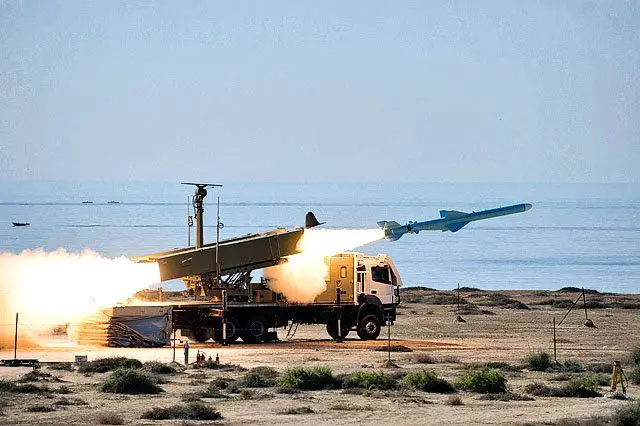| a | |||
Defense News - Iran |
|||
| |
|||
| Sunday, September 9, 2012, 01:35 PM | |||
| Iran will unveil its new home-made cruise missile Meshkat in the near future. | |||
Senior
Iranian defense ministry officials announced on Sunday, September 9, 2012,
that they plan to unveil a highly advanced cruise missile Meshkat (Lantern)
seen as a huge advancement in Iran's missile capability as its range is
several times more than the country's most advanced cruise products.
|
|||
 Firing test of Iranian Ghader missile surface-to-surface cruise missile near Oman sea. |
|||
"God willing, Meshkat (Lantern) Cruise Missile with a range of 2,000km will be unveiled in the near future," Deputy Defense Minister and head of the ministry's Aerospace Organization General Mehdi Farahi told FNA on Sunday. "Meshkat Cruise Missile can be fired from land, air and sea," Farahi added. He further pointed to the wide array of Iranian cruise missiles, saying Tehran's products include Zafar (Triumph), Nasr (Victory), Nour (Light), Qader (Mighty) and Ghadir. He mentioned that the country plans to increase the number of its cruise collection to 14. According to the General, Ra'd (Thunderbolt) and Meshkat are the latest products of Iran's cruise missile industry. The new cruise missile, Meshkat, is widely believed to go on display during the military parades marking the Week of Sacred Defense in September. As far as range is concerned, Iran's formerly best cruise missile could travel a distance not more than 300km, meaning that the country has stretched the range of its cruise missiles almost 7 times. Iran has made giant progress in arms production, specially in area of missile technology, in the last decade. Last September, Iran displayed its (then) latest cruise missile production Qader (Mighty) to the public during the military parades marking the Week of Sacred Defense. Later in September, the Iranian Defense Ministry supplied large numbers of the Qader anti-ship cruise missiles to the Iranian Army's and the IRGC naval forces to boost the country's naval power. The Iranian defense minister said at the time that Qader is an anti-ship cruise missile with a range of 200km and enjoys a short launch time and is able to hit all naval vessels, including frigates and warships, as well as onshore enemy targets. Also on November 21, the Iranian Defense Ministry supplied a large number of highly advanced coast-to-sea cruise missiles to the Army's naval forces. The move came on the verge of the National Navy Day on November 28. A few months later in January the Iranian Navy fired a large number of anti-ship Qader cruise missiles during a series of exercises, codenamed Velayat 90, in international waters in the Sea of Oman and the Indian Ocean. The successful firing of the missile which was a remarkable achievement of the Iranian scientists displayed the missile power of the Iranian navy during the last day of the ten-day drills. Following the exercises, Deputy Commander of the Iranian Navy and Spokesman of the Drills Admiral Seyed Mahmoud Moussavi informed the media that the missile hit the specified targets with 100 percent precision and destroyed them completely. He said the ultra-advanced missile system had remarkably improved in radar, satellite, precision, range and navigation terms compared to its predecessors. Then in February, Iran inaugurated the production line of another naval cruise missile, called Zafar (Triumph). The production line was inaugurated by Defense Minister Vahidi in a ceremony at the Aerospace Industries Organization on the occasion of the Ten-Day Dawn ceremonies, celebrating the anniversary of the victory of the Islamic Revolution back in 1979. The ceremony was also attended by Commander of the Islamic Revolution Guards Corps (IRGC) Naval Force Brigadier General Ali Fadavi. During the ceremony, the first cargo of Zafar missiles was delivered to the IRGC. Speaking to reporters, Vahid said that "Zafar is a short-range, anti-ship, radar guided missile capable of hitting and destroying small and medium-sized targets with high precision". He added that the missile can be mounted onto light and speed boats, enjoys a high capability in anti-electronic warfare and is highly destructive. Tehran launched an arms development program during the 1980-88 Iraqi imposed war on Iran to compensate for a US weapons embargo. Since 1992, Iran has produced its own tanks, armored personnel carriers, missiles and fighter planes. Yet, Iranian officials have always stressed that the country's military and arms programs serve defensive purposes and should not be perceived as a threat to any other country. |
|||
Iran will unveil its new home-made cruise missile Meshkat in the near future 0909128
- Posted On














